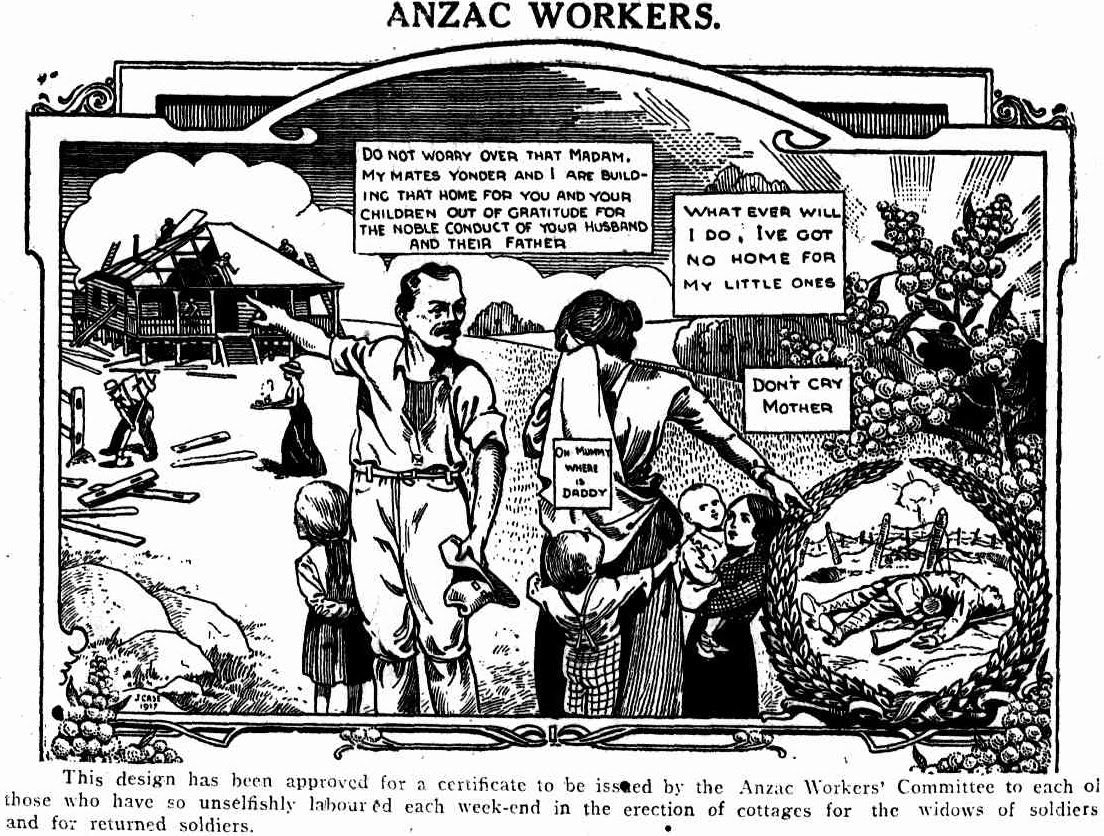As part of Brisbane City Council’s support of the National Trust Heritage Festival, Council historians gave free talks in Council’s central library. Fittingly, just before Anzac Day, PHA (Qld) member, Dr Carmel Black delivered a presentation on Anzac Cottages.
Anzac Cottages are the product of a voluntary scheme begun 100 years ago in 1917 to provide houses for the widows and families of soldiers killed in World War I.
One, ‘Strathearn’ is on the Queensland Heritage Register. Twelve are local heritage places under Brisbane City Council’s planning scheme with 13 more in the process of being added. There were also Anzac Cottages erected in Ipswich, Dalby, Toowoomba and Townsville. A complete study has not been undertaken, but it seems the first Anzac Cottage was ‘built in a day’ in 1916 in Perth, WA for a soldier wounded at Anzac Cove. There are newspaper reports of Anzac Cottages in New South Wales, but none found in Victoria, South Australia, Tasmania or the Northern Territory.
Anzac Cottages were constructed in Queensland under the auspices of the Anzac Cottage Committee, a sub-committee of the Queensland War Council. Funds to buy land and material for the Anzac Cottages were raised by the Queensland Government lottery, the Golden Casket, although land and materials were also donated.
What was so unusual about this lottery was that all lotteries with cash prizes had been outlawed in Queensland since 1895 by the Suppression of Gambling Act. The Golden Casket advertising stated that the organisers guaranteed to fund buyers for the ‘golden casket’ prizes to their full value. Not only was the Golden Casket run by the government, but the cash prizes were huge. First prize was £5000. This was an enormous amount – the equivalent to 30 years wages for the average male wage earner or over 60 years for female wage earners. The tickets too were expensive – 5 shillings or the equivalent of one day’s wages for the average (male) wage earner.

The first two Golden Caskets raised money for the Queensland Patriotic Fund, while Caskets three, four and five raised money for the construction and maintenance of Anzac Cottages. The cottages themselves were presented to deserving widows recommended by local Anzac Cottage Committee sub-branches. While promoted as a gift to the families of Anzac heroes, the cottages were provided for the widows to rent as long as they remained respectable. Widows had to be of ‘good character’ and not be seen to drink publicly or have gentleman callers. If the widow remarried she had to vacate the cottage. A small weekly rent of 1/6 was charged and the widow was responsible for rates, water bills and other Municipal or Shire charges. However, documents in the Brisbane City Council Archives suggest that, under Council ordinances, the cottages were declared to be ‘public charities’ and thus exempt from general rates, although sewerage, water and electricity charges applied.
In 1923 the Anzac cottages scheme was extended to provide housing for soldiers returning from the war with tuberculosis (TB). The Anzac Cottage Trust was disbanded in 1932 and the Public Curator took responsibility for the cottages. The Golden Casket Art Union went on to fund Queensland’s free hospital system.
By 1956 the numbers of World War I widows and dependants had decreased and most cottages were rented to non-Anzac families. Funds for their maintenance had diminished and in 1960 the Anzac Cottages and TB Homes Act allowed for the sale of the cottages for which no eligible tenant could be found. ‘Strathearn’, the last cottage remaining in the Public Trustees’ portfolio, was nominated to the Queensland Heritage Register by the descendants of the original family in 1999.
Dr Carmel Black
